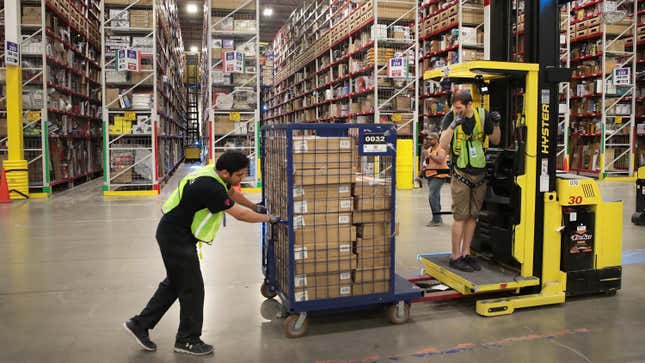
Amazon’s most recent example of double digit growth likely isn’t one it’s eager to tell shareholders.
Last year Amazon facility workers endured nearly 40,000 injuries, with the company recording a 20% increase in its overall injury rate between 2020-2021. Just around half (49%) of all U.S. warehouse worker injuries last year involved Amazon workers. By those metrics, Amazon’s the undisputed king of workplace injuries.
Those alarming figures come by way of a new Strategic Organizing Center report which analyzed 2021 Amazon injury data submitted to the Occupational Safety and Health Administration (OSHA). Aside from the shocking rise in injury rates, the report found Amazon workers were exposed to significantly more potential risk than other warehouse workers. To put that into perspective, Amazon’s 2021 serious injury rate came out to 6.8 per 100 workers, more than double the 3.3 per 100 rate for non-Amazon workers.
89% of the 38,334 recorded injuries were reportedly so severe they either left workers unable to perform their normal functions or forced them to miss work altogether. Injury rates were also reportedly higher at Amazon’s largely automatic, robotic warehouse than their less automated sites, despite previous claims from the company that more automation would lead to increased safety for its human workers. Overall, Amazon workers on average required around 19 more days to recover from their injuries than workers at non-Amazon warehouse facilities.
In response to questions from Gizmodo, an Amazon spokesperson acknowledged the rise in 2021 injuries but said it was partly the result of the company training a record number of new hires.
“Like other companies in the industry, we saw an increase in recordable injuries during this time from 2020 to 2021 as we trained so many new people—however, when you compare 2021 to 2019, our recordable injury rate declined more than 13% year over year,” the spokesperson said. “While we still have more work to do and won’t be satisfied until we are excellent when it comes to safety, we continue to make measurable improvements in reducing injuries and keeping employees safe, and appreciate the work from all of our employees and safety teams who are contributing to this effort.”
The SOC report attributes Amazon’s high injury rate, in part, to its notorious emphasis on speed. The company has seen consumer demand for goods skyrocket since the beginning of the pandemic. Amazon responded early on by hiring a record number of new employees and has solidified its system of on-site monitoring and productivity trackers to keep a steady flow of orders spewing out its facilities.
But all of that efficiency has come at a steep cost for Amazon workers. The analysis claims Amazon’s injury rates have increased every year since 2017 with the exception of 2020, when the company briefly eased workplace requirements due to the Covid-19 pandemic. According to the Strategic Organizing Center, multiple OSHA inspectors cited Amazon productivity monitoring techniques and “very high pace of work,” as contributors to the company’s comparably high injury rates.
Amazon workers and outside critics have, for years, spoken out against the companies’ use of automated tracking software used to determine “time off task” and other productivity claiming they’re left feeling more like robots than people.
Those concerns haven’t always resonated with the company’s upper management to say the least. As one of his final acts as CEO before handing over the reins to Andy Jassy, Jeff Bezos proposed a novel solution to Amazon’s pesky, persistent injury problem. Rather than opting to give workers longer breaks or reduce production expectations, the world’s second richest man suggested in a letter to shareholders that Amazon instead implement “sophisticated algorithms” to precisely monitor workers’ muscle groups and automatically rotate workers over to tasks requiring different muscle groups before their taxed meat machines’ labored bodies gave out out.
Some Amazon workers sense change in the air
Amazon’s unflattering workplace safety figures come as some of its employees take matters into their own hands. Earlier this month a group of warehouse workers in Amazon’s JFK8 fulfillment center in Staten Island, New York voted 2,654-2,131 to form a union, the first of its kind at the company and a major blow to the very place that had fought tooth and nail to prevent past unions. Amazon Labor Union organizers formed the union, in part, as a direct response to what they saw as unsafe working conditions and inhumane workplace monitoring apparatuses.
Predictably, Amazon has since filed an objection to a Staten Island warehouse’s union vote. Amazon claims union organizers threatened employees to force them into voting yes and allegedly threatened workers with the claims they may lose benefits if they didn’t vote for the union. Meanwhile, around 1,000 miles south in Bessemer, Alabama, the Retail, Wholesale and Department Store Union accused Amazon of illegally interfering (again) with a warehouse union vote there.